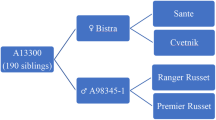Abstract
Black spot, caused by Alternaria brassicae and A. brassicicola, is an important disease in all Brassica oleracea vegetables. Sufficient resistance to the pathogen is not found within the species, nor in species that readily cross to B. oleracea. Camelina sativa (false flax) is highly resistant to Alternaria spp. and has, in addition, other desirable characters for the improvement of B. oleracea. Protoplast fusions were performed between rapid cycling B. oleracea (tribe Brassiceae), which has good regenerability, and C. sativa (tribe Sisymbrieae) by polyethylene glycol (PEG) treatment. The B. oleracea fusion partner was inactivated by treatment with iodoacetate. C. sativa has poor regenerability; hence, no pretreatment was needed for this species. The protoplasts were cultured using a feeder layer system. A total of 2903 calli were isolated from the fusions. Fourteen of these initiated shoots, i.e., 0.5% regeneration frequency. Approximately 110 shoots were excised from 6 of these calli and transferred to rooting medium. Rooted plantlets grew vigorously in vitro and flowering was frequently observed. However, establishment of rooted shoots in soil was unsuccessful. Hybrid identity was confirmed by intermediate shoot morphology, RAPD marker analysis, and flow cytometric estimation of nuclear DNA content.
Similar content being viewed by others
References
Browne, L.M., K.L. Conn, W.A. Ayer & J.P. Tewari, 1991. The camalexins: new phytoalexins produced in the leaves of Camelina sativa. Tetrahedron 47: 3909-3914.
Conn, K.L., J.P. Tewari & J.S. Dahiya, 1988. Resistance to Alternaria brassicaeand phytoalexin-elicitation in rapeseed and other crucifers. Plant Sci 56: 21-25.
Fahleson, J., I. Eriksson & K. Glimelius, 1994a. Intertribal somatic hybrids between Brassica napusand Barbarea vulgarisproduction of in vitroplantlets. Plant Cell Rep 13: 411-416.
Fahleson, J., I. Eriksson, M. Landgren, S. Stymme & K. Glimelius, 1994b. Intertribal somatic hybrids between Brassica napusand Thlaspi perfoliatumwith high content of the T. perfoliatumspecific nervonic acid. Theor Appl Genet 87: 795-804.
Forsberg, J., M. Landgren & K. Glimelius, 1994. Fertile somatic hybrids between Brassica napusand Arabidopsis thaliana. Plant Science 95: 213-223.
Gerdemann-Knörck, M., S. Nielen, C. Tzscheetzsch, J. Iglisch & O. Schieder, 1995. Transfer of disease resistance within the genus Brassicathrough asymmetric somatic hybridization. Euphytica 85: 247-253.
Gleba, Y.Y. & F. Hoffmann, 1980. ‘Arabidobrassica’: A novel plant obtained by protoplast fusion. Planta 149: 112-117.
Hansen, L.N. & E.D. Earle, 1994a. Regeneration of plants from protoplasts of rapid cycling Brassica oleracea L. Plant Cell Rep 13: 335-339.
Hansen, L.N. & E.D. Earle, 1994b. Novel flowering and fatty acid characters in rapid cycling Brassica napusL. resynthesized by protoplast fusion. Plant Cell Rep 14: 151-156.
Hansen, L.N. & E.D. Earle, 1995. Transfer of resistance to Xanthomonas campestrispv. campestrisinto Brassica oleraceaby protoplast fusion. Theor Appl Genet: 1293-1300.
Hansen, L.N. & E.D. Earle, 1997. Somatic hybrids between Brassica oleraceaL. and Sinapis albaL. with resistance to Alternaria brassicae(Berk.) Sacc. Theor Appl Genet 94: 1078-1085.
Hu, J. & C.F. Quiros, 1991. Identification of broccoli and cauliflower cultivars with RAPD markers. Plant Cell Rep 10: 505-511.
Jejelowo, O.A., K.L. Conn & J.P. Tewari, 1991. Relationship between conidial concentration, germling growth, and phytoalexin production by Camelina sativaleaves inoculated with Alternaria brassicae. Mycol Res 95: 928-934.
Lelivelt, C.L.C. & F.A. Krens, 1992. Transfer of resistance to the beet cyst nematode (Heterodera schachtiiSchm.) into the Brassica napusL. gene pool through intergeneric somatic hybridization with Raphanus sativus L. Theor Appl Genet 83: 887-894.
Lelivelt, C.L.C., E.H.M. Leunissen, H.J. Frederiks, J.P.F.G. Helsper & F.A. Krens, 1993. Transfer of resistance to the beet cyst nematode (Heterodera schachtiiSchm.) from Sinapis albaL. (white mustard) to the Brassica napusL. gene pool by means of sexual and somatic hybridization. Theor Appl Genet 85: 688-696.
Linsmaier, E.M. & F. Skoog, 1965. Organic growth factor requirements of tobacco tissue cultures. Physiol Plant 18: 100-127.
Menczel L., F. Nagy, Z.S. Kiss & P. Maliga, 1981. Streptomycin resistant and sensitive somatic hybrids of Nicotiana tabacum+ Nicotiana knightiana1: correlation of resistance to N. tabacumplastids. Theor Appl Genet 59: 191-195.
Narasimhulu, S.B., P.B. Kirti, S.R. Bhatt, S. Prakash & V.L. Chopra, 1994. Intergeneric protoplast fusion between Brassica carinataand Camelina sativa .Plant Cell Rep 13: 657-660.
Pelletier, G., C. Primard, F. Vedel, P. Chetrit, R. Remy, P. Rouselle, M. Renard, 1983. Intergeneric cytoplasm hybridization in Cruciferae by protoplast fusion. Mol Gen Genet. 191: 244-250.
Primard, C., F. Vedel, C. Mathieu, G. Pelletier & A.M. Chevre, 1988. Interspecific somatic hybridization between Brassica napusand Brassica hirta(Sinapis albaL.). Theor Appl Genet 75: 546-552
Putnam, D.H., J.T. Budin, L.A. Field & W.M. Breene, 1993. Camelina: A promising low-input oilseed. In: J. Janick & J. Simon (Eds.), New Crops, pp. 314-322. John Wiley and Sons, New York.
Salisbury, P.A., 1987. Blackleg resistance in weedy crucifers. Eucarpia Cruciferae Newsletter 12: 90.
Siemens, J. & M.D. Sacristán, 1995. Production and characterization of somatic hybrids between Arabidopsis thalianaand Brassica nigra. Plant Sci 111: 95-106.
Sjödin, C. & K. Glimelius, 1989. Transfer of resistance against Phoma lingamto Brassica napusby asymmetric somatic hybridization combined with toxin selection. Theor Appl Genet 78: 513-520.
Skarzhinskaya, M., M. Landgren & K. Glimelius, 1996. Production of intertribal somatic hybrids between Brassica napusL. and Lesquerella fendleri(Gray) Wats. Theor Appl Genet 93: 1242-1250.
Walters T.W. & E.D. Earle, 1990. A simple versatile feeder layer system for Brassica oleraceaprotoplast culture. Plant Cell Rep 9: 316-319.
Author information
Authors and Affiliations
Rights and permissions
About this article
Cite this article
Hansen, L.N. Intertribal somatic hybridization between rapid cycling Brassica oleracea L. and Camelina sativa (L.) Crantz. Euphytica 104, 173–179 (1998). https://doi.org/10.1023/A:1018604919488
Issue Date:
DOI: https://doi.org/10.1023/A:1018604919488




